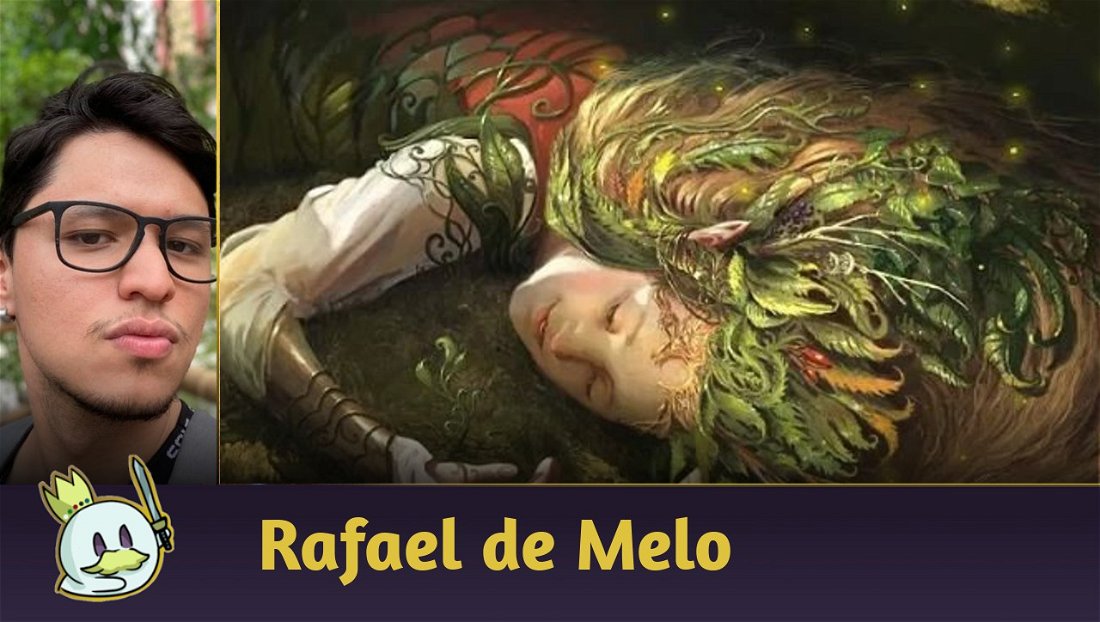Introduction
Analyzing Flesh and Blood archetypes can be a bit complicated due to the nature of the game, considering it doesn't focus on permanents, like other TCGs. However, a clear, and relatively unique strategy in FaB is fatigue.
Today, we'll analyze a fatigue deck under a new light, understand it a bit better, and see how we can play it and beat it.
What is Fatigue?
The fatigue strategy consists in, basically, stalling the game until your opponent runs out of resources, and, from then on, start wrapping up the game, considering you'll still have numerous resources and cards to play.
Even though it is considered a harmful archetype to the game by many players, fatigue has shown us it is efficient at several points of the game, and has also shown us it is an incredibly solid strategy.
There are two types of fatigue:
- Deckout Fatigue: when your opponent's deck runs out, they don't have any other cards to play, and you finish the game because you have more cards;
- Fatigue by Damage: when the deck presents so much damage pressure, its opponent has to block to avoid taking lethal damage.
How to Build a Fatigue Deck
Unlike what many players think, a fatigue deck isn't a deck that "has all Defense Reactions in 60 cards", or a deck that "lets your opponent play by themselves for 50 minutes". A good fatigue deck needs a few key pieces. They are:
- Good defensive tools;
- Recursion;
- The ability to punish your opponent any time you can.
Let's see each of these with a few examples.
Defensive Tools
This is the most obvious part of a fatigue deck, and the one that most players think of when someone mentions a fatigue deck. A fatigue deck needs good tools to defend itself and deny any type of damage.

Besides Flesh and Blood's classic generic cards (Sink Below (1), Fate Foreseen (1), and Oasis Respite (1)), a deck that focuses on this strategy can use different cards to defend itself, like Healing Balm (1), Sigil of Solace (1), and Peace of Mind (1). However, besides generic cards, the class of the hero in question can help significantly.

Classes like Warrior and Guardian have these defensive tools, which also allows us to build archetypes like fatigue Dorinthea Ironsong. Apart from these classes, the Earth talent also has a defensive base, with cards like Crown of Seeds and the Embodiment of Earth token. This also allowed Briar, Warden of Thorns to focus on this strategy.
Recursion
As you need to have a good number of cards to finish the game, a fatigue deck needs to play a few steps of its game plan without spending any cards, which means, it has to pitch cards all the time so it doesn't run out of cards.
One of the best ways to use recursion is with your weapon, but you can also use it for other means.

Weapons are an excellent way to finish the game with this strategy. Titan's Fist, for instance, threatens four damage (a breaking point) without spending any cards in your deck; so, you'll always be able to threaten this amount of damage every turn. Another hero that uses this concept really well is Dash, Inventor Extraordinaire through her Teklo Plasma Pistol cycle and several Induction Chamber (1) and Plasma Purifier (1). Notice she will always threaten a lot of damage, but won't spend any cards in your deck, once she will pitch them to place her counters.
Crown of Seeds also uses this concept well, considering you'll return one card in your arsenal to your deck (besides the card you pitched to prevent damage).
The Ability to Punish Your Opponent Any Time You Can
Sometimes your opponent gives you an opening (this means they didn't force you to use anything in your hand). In these openings, a fatigue deck must also punish their opponent, and not only remain defensive and give them the opportunity to set up an impactful turn.
Many players don't pay attention to this concept and end up building an inefficient fatigue deck.

When the fatigue player finds an opening, they must play something that forces their opponent to interact, even if that is dealing seven damage. Some classes can set up very disruptive attacks that ruin their opponent's turn. Assassin's Contract cards, several Guardian attacks (particularly Bravo, Showstopper's specializations), and many others.
Case Study: Oldhim
With all of this in mind, let's study a hero that had the greatest success as a fatigue deck because he has absolutely everything this strategy requires: Oldhim, Grandfather of Eternity.

This Guardian reached Living Legend status around a year ago, and his journey until he reached this status was paved with his tools, which were perfect for a fatigue strategy. Unlike all other Living Legend heroes, he couldn't access Action Points that easily, but he could make your opponent run out of resources incredibly fast, unlike any other hero.
Let's use, as a base, this list by Michael Feng, the winner of the Pro Tour: Baltimore of 2023.
The first thing we'll note is that Oldhim didn't necessarily need to be in a fatigue deck - this is advantageous both because of his ability to be fast when he needs to and because, depending on the opponent, we won't need to focus on fatigue as much.

Besides the wide array of cards offered by the Earth, Ice, and Elemental talents, and by the Guardian class, Oldhim himself is one of your control tools and, if you could use his ability with several cards with the Ice and Earth talents, you'd get his two effects.
Apart from your own hero, Staunch Response (3), Channel Lake Frigid (3), and Stalagmite, Bastion of Isenloft were other ways you could defend yourself well - be it by preventing damage or disrupting your opponent's turn.

Crown of Seeds was one of the main ways we could use recursion with this deck and defend ourselves at the same time. With the resource created by Fyendal's Spring Tunic, we could place the card in our arsenal at the bottom of our deck, save it for our second cycle, and prevent one damage without spending any cards. This equipment card was so good in this strategy that some players even thought it would be banned.
Furthermore, his weapon, Titan's Fist, (keep in mind Winter's Wail was banned at the time) allowed us to attack for four if we pitched a blue card - and, therefore, it was the main way for us to finish the game when our opponent was properly fatigued.

If your opponent gave you an opening, attacks like Endless Winter, Pulverize, Spinal Crush, and Glacial Footsteps (1) forced your opponent to interact with you; otherwise they'd be heavily punished, and their turn would be even more limited or completely countered.
How to Beat a Fatigue Deck
As we've seen before, a fatigue deck puts its opponent's deck in check. It doesn't matter whether the fatigue hero finishes the game with 40 or 1 life - once properly fatigued, your opponent will hardly win.
However, of course, this strategy isn't unbeatable. Let's see some ways we can counter this strategy:
A Big Board State

When she was legal, Prism, Sculptor of Arc Light prevented any fatigue deck from playing properly. Besides having several ways to protect herself from card tax, like Soul Shield, or Arc Light Sentinel (2), Luminaris would turn all your Prism auras into Harmonized Kodachi. This means defending yourself against these auras was always inefficient, and, as much as you tried to clean them up, her board state was always bigger, and like so made your loss unavoidable.
Another hero that can build this type of board state is Dromai, Ash Artist. Even though she is a lot more vulnerable considering her dragons have Phantasm, cards like Ghostly Touch are efficient at dealing damage, and allow you to deal damage with a horde of dragons at the end of the game.
OTK

Another way to beat a fatigue deck is setting up OTK turns (One Turn Kill), turns in which we'll deal such absurd amounts of damage that it will be impossible for the fatigue deck to absorb it all without losing the game.
An example of an OTK deck was Iyslander, Stormbind with her Ice Eternal combo and three Frost Hex - this would deal approximately 35 damage in a single turn. Additionally, we could also set up an OTK with Viserai, Rune Blood breaking several Runechants on the same turn, or if we played Nitro Mechanoid alongside High Octane and attacked several times with Nitro.
However, notice that all of these strategies depend on several other cards and a lot of prep; as a result, a fatigue deck can't let these decks prepare their OTK turns. Additionally, pitch stacking (a term used to refer to how we set up our deck for our second cycle or later) is critical to know which cards we'll draw and whether we'll draw them at the right time.
Pistol Plan
Dash, Inventor Extraordinaire, exclusively, can use one of the best strategies against fatigue. Thanks to her weapon, Teklo Plasma Pistol, and the items Induction Chamber (1) and Plasma Purifier (1), it is possible, with all of these items on the board, to attack for 20 damage per turn - and notice that, to do this, we only need to place counters on our items or our weapon, and we don't need to spend any card in our deck to do this.
Breaking their items or trying to win earlier is a strategy to beat Dash, but once all of these items are on the board, and they have several blue cards, it is difficult to defeat them with a fatigue deck.
Preserve your Deck
This strategy requires a bit more practice and varies a lot with different decks, but preserving a few key cards for the right turns is a way to go through your opponent's defenses.
Some of the steps in this strategy require you to build your arsenal more often, or pitch key cards for your second cycle (particularly the ones that disrupt your opponent). Additionally, conserving your cards is a way to prepare yourself for your second cycle.
Final Words
Even though fatigue is hated by several players, this strategy is quite solid in the formats we play and has a dedicated fan base. Even if no current deck holds the same power as Oldhim, Grandfather of Eternity, heroes like Bravo, Showstopper, Dorinthea Ironsong, and Dash, Inventor Extraordinaire have been using this strategy well, which proves once again it is an excellent way to win games.
Thank you for reading, and see you next time!














— Comments 0
, Reactions 1
Be the first to comment